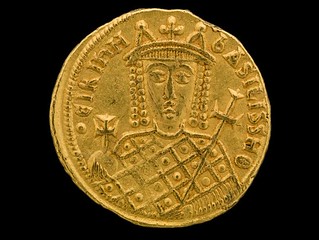
PREV ARTICLE
NEXT ARTICLE
FULL ISSUE
PREV FULL ISSUE
WOMEN ON BYZANTINE GOLD COINS
An article on the Smithsonian's O Say Can You See? blog by National Numismatic Collection intern Emily Pearce (published April
14, 2016) looks at powerful women on Byzantine coins. -Editor
Rule by women was less common, but not unheard of in the Byzantine Empire—or in the ancient world for that matter! As such, ancient coins frequently depicted women. The National Numismatic Collection holds several Byzantine coins featuring images of women. Emperor Justin II's coins show him and his wife, Sophia. Mary, the mother of Christ, is a common icon on Byzantine coins. The women rulers of Byzantium left lasting impressions (get it?) on the coins of the empire, but two women left particularly strong legacies in the wake of their rule. Irene and Theodora were two of the most (in)famous ladies to take the throne. Their political and religious actions caused drastic movement in the empire (and their family dramas are worthy of their own HBO show). 
Empress Irene, Solidus coin, Constantinople, 792 – 802 Irene married into her position in 769 A.D. when she wed the emperor Leo IV. Originally from Athens, Irene brought her entourage with her to Byzantium. Many of her siblings married into the Byzantine court, further solidifying her familial position as imperial elite. After the death of her husband in 780, Irene became regent and co-emperor with their 10-year-old son, Constantine VI, and took over political affairs of the empire. Irene's powerful reign bred anger and resentment in Constantine. Thanks in large part to military resistance against the empress, Constantine was eventually able to attain sole rule in 790. But that did not stop the ambitious Irene. Two years later, she returned both to court and to her position as co-emperor. By 797 she had incited a conspiracy against Constantine. Irene had her son blinded and imprisoned. (That even makes Cersei Lannister from Game of Thrones look like a healthy mother figure.) For five more years, Irene reigned as emperor—that’s basileus for you Greek scholars—over Byzantium. 
Empress Theodora, Solidus coin, Constantinople, 1055 -1056 Unlike Irene, Theodora was born into the imperial line— as daughter to Emperor Constantine VIII. Her position as a daughter of the emperor should have ensured an early political marriage, but when her father betrothed her to Romanos (a married man) she refused. Her sister, Zoe, was instead presented as a second-choice wife. Romanos and Zoe married in 1028. Zoe remained deeply bitter toward her sister for being her father's first choice for the marriage and used her power to incite rumors about Theodora. Accused in conspiracy against Zoe, Theodora was confined to a monastery where she remained for 13 years. Talk about family drama. To read the complete article, see:


Wayne Homren, Editor The Numismatic Bibliomania Society is a non-profit organization promoting numismatic literature. See our web site at coinbooks.org. To submit items for publication in The E-Sylum, write to the Editor at this address: whomren@gmail.com To subscribe go to: https://my.binhost.com/lists/listinfo/esylum All Rights Reserved. NBS Home Page Contact the NBS webmaster 
|